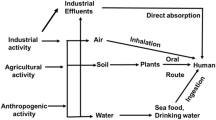Abstract
The aim of this study was to (1) determine the selenium concentration in the renal cortex, liver, and hair in 64 residents from northern Poland (Gdańsk region) aged 17–81 yr, who died suddenly, and (2) assess whether a correlation between the selenium concentration in hair and in the renal cortex and liver occurs. Selenium was determined by atomic absorption spectrometry using the hydride generation method. The mean selenium concentration in the renal cortex, liver, and hair in the investigated persons was 0.791±0.191 µg/g (wet weight), 0.289±0.084 µg/g (wet weight), and 0.443±0.128 µg/g, respectively. No age-dependent differences in selenium level in the investigated tissues was found. Also, no correlation between the selenium concentrations in hair and in renal cortex and liver was assessed.
Similar content being viewed by others
References
G. F. Combs and W. P. Gray, Chemopreventive agents: selenium, Pharmacol. Ther. 79, 179–192 (1998).
D. H. Holben and A. M. Smith, The diverse role of selenium within selenoproteins: a review, J. Am. Diet. Assoc. 99, 836–843 (1999).
M. P. Rayman, The importance of selenium to human health, Lancet 356, 233–241 (2000).
G. N. Schrauzer, Anticarcinogenic effect of selenium, Cell. Mol. Life Sci. 57, 1864–1873 (2000).
B. Zachara, H. Pawluk, E. Bloch-Bogusłwska, et al., Tissue level, distribution, and total body selenium content in healthy and diseased humans in Poland, Arch. Environ. Health 56, 461–466 (2001).
L. Magos and G. G. Berg, Selenium, in Biological Monitoring of Toxic Metals, T. W. Clarkson, L. Friberg, G. N. Nordberg, et al., eds., Plenum, New York (1988).
C. D. Thomson, Selenium speciation in human body fluids, Analyst 123, 827–831 (1998).
O. Mestek, M. Suchanek, Z. Vodickova, et al., Comparison of the suitability of various atomic spectroscopic techniques for the determination of selenium in human whole blood, J. Anal. Atomic Spectrom. 12, 85–89 (1997).
B. Tiran, E. Karpf, and A. Tiran, Age dependency of selenium and cadmium content in human liver, kidney and thyroid, Arch. Environ. Health 50, 242–246 (1995).
E. Hać, J. Krechniak, and M. Szyszko, Selenium levels in human plasma and hair in Northern Poland, Biol. Trace Element Res. 85, 277–285 (2002).
M. Trzcinka-Ochocka, G. Razniewska, and M. Jakubowski, Blood serum selenium levels in children and adults in Poland, Trace Elements Electrolytes 17, 147–153 (2000).
A. J. Duffield and Ch. D. Thomson, A comparison of methods of assessment of dietary selenium intakes in Otago, New Zealand, Br. J. Nutr. 82, 131–138 (1999).
D. Brune, G. Nordberg, and P. O. Wester, Distribution of 23 elements in the kidney, liver and lungs of workers from a smeltery and refinery in the North Sweden exposed to a number of elements and of a control group, Sci. Total Environ. 16, 13–35 (1980).
H. Zduńska, E. Bloch-Bogusławska, J. Przygońska, et al., Selenium concentration and gluthathione peroxidase activity in the organs of people who died a violent death. Arsenic and selenium in the environment ecological and analytical problems, PAN Zesz. Nauk. 8, 190–193 (1994).
O. Oster, G. Schmiedel, and W. Prellwitz, The organ distribution of selenium in German adults, Biol. Trace Element Res. 15, 23–45 (1988).
Y. Muramatsu and R. M. Parr, Concentrations of some trace elements in hair, liver and kidney from autopsy subjects—relationship between hair and internal organs, Sci. Total Environ. 76, 29–40 (1988).
Y. D. Cheng, G. S. Zhuang, M. G. Tan, et al., Study of correlation of Se content in human hair and internal organs by INAA, Biol. Trace Element Res. 11, 737–741 (1990).
K. Julshamm, K. J. Andersen, E. Svendsen, et al., Trace elements intake in the Faroe Islands. III. Element concentrations in human organs in populations from Bergen (Norway) and the Faroe Island, Sci. Total Environ. 84, 25–33 (1989).
Y. Yoo, S. Lee, and J. Yang, et al., Distribution of heavy metals in normal Korean tissues, Probl. Forensic Sci., 43, 283–289 (2000).
Y. Yoshinaga, H. Imai, M. Nakazawa, et al., Lack of significantly positive correlations between elemental concentrations in hair and in organs, Sci. Total Environ. 99, 125–135 (1990).
Author information
Authors and Affiliations
Rights and permissions
About this article
Cite this article
Hać, E., Krechniak, J., Szyszko, M. et al. Selenium contentrations in human renal cortex, liver, and hair in Northern Poland. Biol Trace Elem Res 92, 213–219 (2003). https://doi.org/10.1385/BTER:92:3:213
Received:
Revised:
Accepted:
Issue Date:
DOI: https://doi.org/10.1385/BTER:92:3:213




